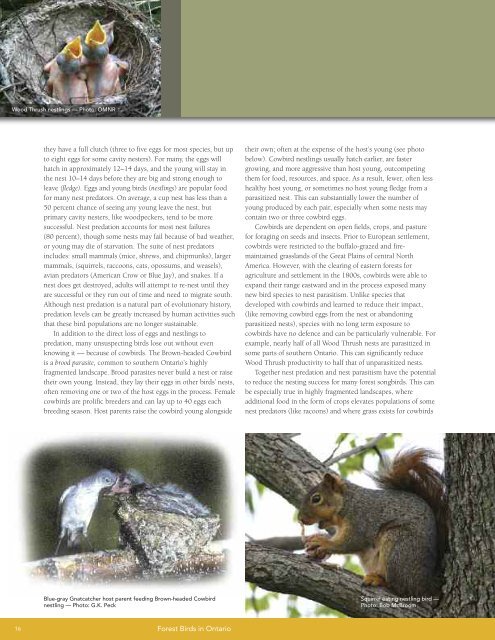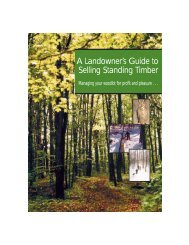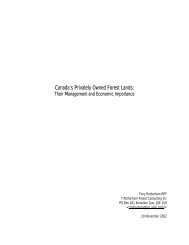A land manager's guide to conserving habitat for forest birds in ...
A land manager's guide to conserving habitat for forest birds in ...
A land manager's guide to conserving habitat for forest birds in ...
You also want an ePaper? Increase the reach of your titles
YUMPU automatically turns print PDFs into web optimized ePapers that Google loves.
Wood Thrush nestl<strong>in</strong>gs — Pho<strong>to</strong>: OMNR<br />
they have a full clutch (three <strong>to</strong> five eggs <strong>for</strong> most species, but up<br />
<strong>to</strong> eight eggs <strong>for</strong> some cavity nesters). For many, the eggs will<br />
hatch <strong>in</strong> approximately 12–14 days, and the young will stay <strong>in</strong><br />
the nest 10–14 days be<strong>for</strong>e they are big and strong enough <strong>to</strong><br />
leave (fledge). Eggs and young <strong>birds</strong> (nestl<strong>in</strong>gs) are popular food<br />
<strong>for</strong> many nest preda<strong>to</strong>rs. On average, a cup nest has less than a<br />
50 percent chance of see<strong>in</strong>g any young leave the nest, but<br />
primary cavity nesters, like woodpeckers, tend <strong>to</strong> be more<br />
successful. Nest predation accounts <strong>for</strong> most nest failures<br />
(80 percent), though some nests may fail because of bad weather,<br />
or young may die of starvation. The suite of nest preda<strong>to</strong>rs<br />
<strong>in</strong>cludes: small mammals (mice, shrews, and chipmunks), larger<br />
mammals, (squirrels, raccoons, cats, opossums, and weasels),<br />
avian preda<strong>to</strong>rs (American Crow or Blue Jay), and snakes. If a<br />
nest does get destroyed, adults will attempt <strong>to</strong> re-nest until they<br />
are successful or they run out of time and need <strong>to</strong> migrate south.<br />
Although nest predation is a natural part of evolutionary his<strong>to</strong>ry,<br />
predation levels can be greatly <strong>in</strong>creased by human activities such<br />
that these bird populations are no longer susta<strong>in</strong>able.<br />
In addition <strong>to</strong> the direct loss of eggs and nestl<strong>in</strong>gs <strong>to</strong><br />
predation, many unsuspect<strong>in</strong>g <strong>birds</strong> lose out without even<br />
know<strong>in</strong>g it — because of cow<strong>birds</strong>. The Brown-headed Cowbird<br />
is a brood parasite, common <strong>to</strong> southern Ontario’s highly<br />
fragmented <strong>land</strong>scape. Brood parasites never build a nest or raise<br />
their own young. Instead, they lay their eggs <strong>in</strong> other <strong>birds</strong>’ nests,<br />
often remov<strong>in</strong>g one or two of the host eggs <strong>in</strong> the process. Female<br />
cow<strong>birds</strong> are prolific breeders and can lay up <strong>to</strong> 40 eggs each<br />
breed<strong>in</strong>g season. Host parents raise the cowbird young alongside<br />
their own; often at the expense of the host’s young (see pho<strong>to</strong><br />
below). Cowbird nestl<strong>in</strong>gs usually hatch earlier, are faster<br />
grow<strong>in</strong>g, and more aggressive than host young, outcompet<strong>in</strong>g<br />
them <strong>for</strong> food, resources, and space. As a result, fewer, often less<br />
healthy host young, or sometimes no host young fledge from a<br />
parasitized nest. This can substantially lower the number of<br />
young produced by each pair, especially when some nests may<br />
conta<strong>in</strong> two or three cowbird eggs.<br />
Cow<strong>birds</strong> are dependent on open fields, crops, and pasture<br />
<strong>for</strong> <strong>for</strong>ag<strong>in</strong>g on seeds and <strong>in</strong>sects. Prior <strong>to</strong> European settlement,<br />
cow<strong>birds</strong> were restricted <strong>to</strong> the buffalo-grazed and firema<strong>in</strong>ta<strong>in</strong>ed<br />
grass<strong>land</strong>s of the Great Pla<strong>in</strong>s of central North<br />
America. However, with the clear<strong>in</strong>g of eastern <strong>for</strong>ests <strong>for</strong><br />
agriculture and settlement <strong>in</strong> the 1800s, cow<strong>birds</strong> were able <strong>to</strong><br />
expand their range eastward and <strong>in</strong> the process exposed many<br />
new bird species <strong>to</strong> nest parasitism. Unlike species that<br />
developed with cow<strong>birds</strong> and learned <strong>to</strong> reduce their impact,<br />
(like remov<strong>in</strong>g cowbird eggs from the nest or abandon<strong>in</strong>g<br />
parasitized nests), species with no long term exposure <strong>to</strong><br />
cow<strong>birds</strong> have no defence and can be particularly vulnerable. For<br />
example, nearly half of all Wood Thrush nests are parasitized <strong>in</strong><br />
some parts of southern Ontario. This can significantly reduce<br />
Wood Thrush productivity <strong>to</strong> half that of unparasitized nests.<br />
Together nest predation and nest parasitism have the potential<br />
<strong>to</strong> reduce the nest<strong>in</strong>g success <strong>for</strong> many <strong>for</strong>est song<strong>birds</strong>. This can<br />
be especially true <strong>in</strong> highly fragmented <strong>land</strong>scapes, where<br />
additional food <strong>in</strong> the <strong>for</strong>m of crops elevates populations of some<br />
nest preda<strong>to</strong>rs (like racoons) and where grass exists <strong>for</strong> cow<strong>birds</strong><br />
Blue-gray Gnatcatcher host parent feed<strong>in</strong>g Brown-headed Cowbird<br />
nestl<strong>in</strong>g — Pho<strong>to</strong>: G.K. Peck<br />
Squirrel eat<strong>in</strong>g nestl<strong>in</strong>g bird —<br />
Pho<strong>to</strong>: Bob McBroom<br />
16<br />
Forest Birds <strong>in</strong> Ontario

















